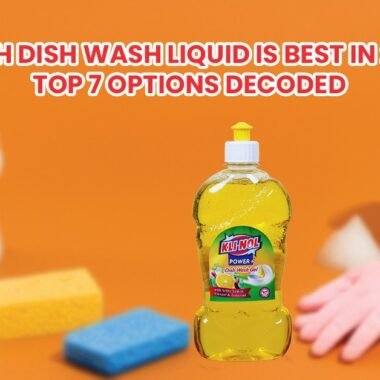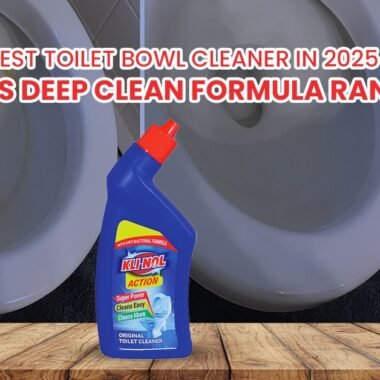Are you really sure you know how to use the bathroom cleaner properly? Most Indians overlook critical steps like maintaining the proper toilet cleaner dilution ratio, how to scrub toilet bowl efficiently, or cleaning under toilet rim thoroughly. Skipping safety gloves for cleaning and a regular weekly bathroom cleaning routine often causes hidden bacteria, stains, and foul smells.
In this simple, expert-backed guide, you’ll learn exactly how to use a bathroom cleaner with professional techniques that protect your toilet, family, and hygiene — ensuring a fresh, clean bathroom every time.
As per a Hindustan Times report, “bad sanitary conditions in toilets significantly boost the risk of infections”. So why take the risk? Choose Klinol as India’s leading chemical-free toilet cleaner that should become your top cleaning choice. Safe for your hands, family, and environment. Try it today!
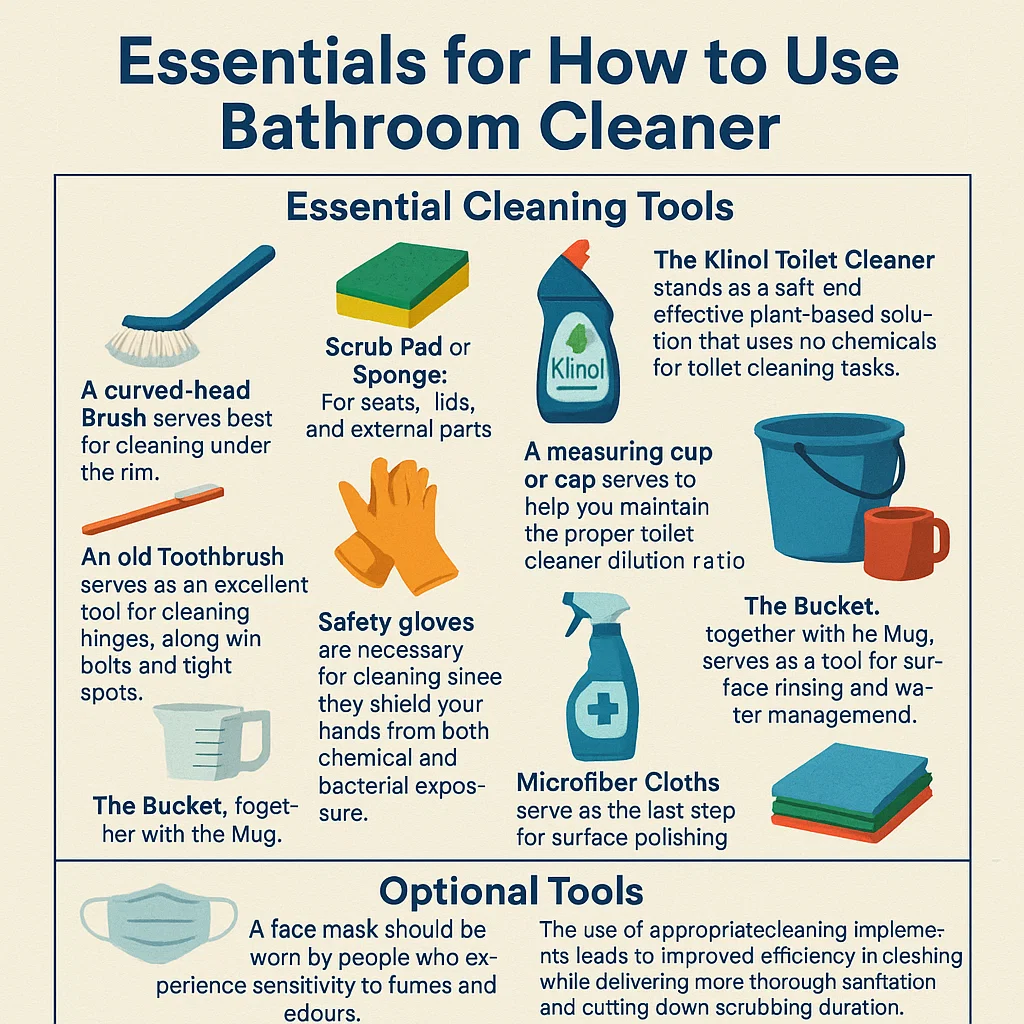
Essentials for How to Use Bathroom Cleaner
Essentials for How to Use Bathroom Cleaner
The first step in learning how to use bathroom cleaner like a professional is having the right tools. A cleaning product, no matter how expensive, cannot produce desired outcomes when used without these tools.
Essential Cleaning Tools
- A curved-head brush serves best for cleaning under the rim.
- Scrub Pad or Sponge: For seats, lids, and external parts.
- Safety gloves are necessary for cleaning since they shield your hands from both chemical and bacterial exposure.
- The Klinol Toilet Cleaner stands as a safe and effective plant-based solution that uses no chemicals for toilet cleaning tasks.
- An old toothbrush serves as an excellent tool for cleaning hinges, along with bolts and tight spots.
- A measuring cup or cap serves to help you maintain the proper toilet cleaner dilution ratio.
- The Bucket, together with the Mug, serves as a tool for surface rinsing and water management.
Optional Tools
- A face mask should be worn by people who experience sensitivity to fumes and odours.
- Disinfectant Spray serves as the recommended solution for cleaning floor tiles while treating the surrounding areas.
- Microfiber Cloths serve as the last step for surface polishing.
The use of appropriate cleaning implements leads to improved efficiency in cleaning while delivering more thorough sanitation and cutting down scrubbing duration.
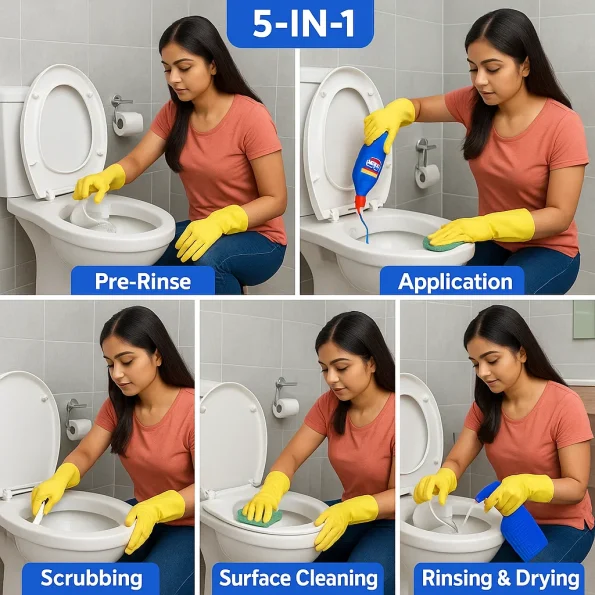
Step by Step Guide (Pre Rinse to Scrubbing
Step-by-Step Guide (Pre-Rinse to Scrubbing)
The following guide will explain the step-by-step procedure to use bathroom cleaner after you prepare your cleaning supplies.
Step 1: Pre-Rinse
The first flush of the toilet will eliminate any floating objects. A handheld bidet or a mug should be used to rinse the toilet bowl and walls before cleaning. The loosened debris creates better conditions for the cleaning liquid to stick to surfaces.
Step 2: Application
- Apply Klinol Toilet Cleaner by pouring it onto the inner edge of the bowl.
- The cleaning solution should flow from the rim down to the water level.
- The recommended amount for regular cleaning is 20–25 ml of the product. A heavier level of soil requires a maximum of 50 ml of solution. The proper toilet cleaner dilution ratio for using concentrated cleaners as toilet cleaners is this amount.
- The cleaning solution needs a 10–15 minute wait time to effectively break down grime and eliminate bacteria.
Step 3: Scrubbing
Let’s explore how to scrub the toilet bowl thoroughly:
- Begin cleaning the upper part of the bowl before moving to the lower sections.
- Brush the area with circular movements to clean it.
- The waterline area needs special attention because that is where stains tend to accumulate.
- Clean both the rim area and the inside walls of the U-bend.
- When dealing with persistent stains, use the toothbrush to apply precise scrubbing motions.
After scrubbing, flush the toilet. A final brush stroke should be used to remove debris that was loosened during the cleaning process.
Step 4: Surface Cleaning
- Wear the safety gloves for cleaning while using a sponge that contains diluted cleaner to clean the seat and cover, and flush the tank and handles.
- Clean both the bottom surface and the hidden areas behind the seat of the cistern.
Step 5: Rinsing and Drying
- Clean water rinsing should be followed by surface drying with microfiber cloths.
- Drying the surface properly stops water marks from forming while blocking bacterial multiplication.
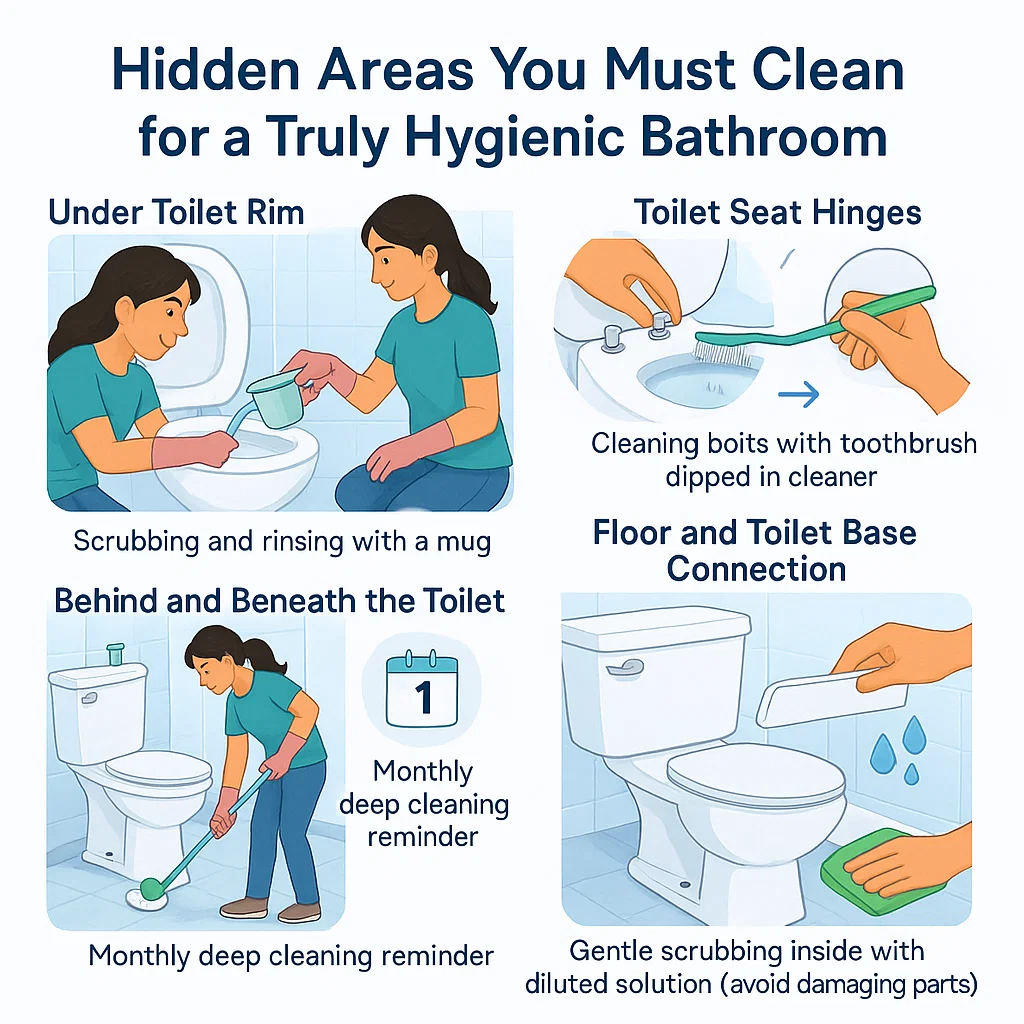
Cleaning Hidden Areas
Secret Tip: Cleaning Hidden Areas
The largest mistake people make occurs when they fail to clean the concealed areas where bacteria reside. These include:
Cleaning Under Toilet Rim
- A brush equipped with an angled design or flexible scrub pad works well for this task.
- Put the tool underneath the rim, then clean gradually to remove buildup
- Rinse thoroughly with a mug of water.
Toilet Seat Hinges
- Most toilet seats are detachable. Unscrew them.
- Dip a retired toothbrush into cleaning solution to clean both toilet hinges and bolts.
- Rinse and dry before reassembling.
Behind and Beneath the Toilet
- The rear section of the toilet, along with its lower portion, frequently remains untouched.
- A long-hold brush or cloth should be used for cleaning the rear and bottom aspects of the toilet.
- Monthly deep cleaning is the right approach because quick wiping alone does not remove all contaminants in these areas.
Floor and Base
- The connection of the toilet base to the floor collects substantial grime accumulation.
- A sponge imbued with diluted toilet cleaner should be used to clean the area.
- Through complete rinsing, wipe every surface dry using a microfiber cloth.
Bonus Hidden Zone: Flush Tank
- Occasionally, open the tank lid.
- Mould, together with mineral residue, could establish itself in these areas.
- The solution requires dilution to create a cleaning agent that needs gentle scrubbing.
- Pay attention to avoid endangering the internal plumbing components.
These inaccessible areas behind the toilet base typically become the source of ongoing bad odour as well as staining, while the toilet bowl appears clean.

Common Mistakes of Overusing Product
Common Mistakes (Overusing Product, Wrong Tools)
When it comes to how to use bathroom cleaners, avoid these common errors:
Overusing the Cleaner
- The amount of product does not result in superior outcomes.
- Using too much product will harm porcelain surfaces while wasting money and intensifying fume production.
- Stick to the proper toilet cleaner dilution ratio for best results.
Using the Wrong Brush
- Avoid wire or steel brushes. They scratch the surface.
- The recommended cleaning tools for bathroom surfaces include nylon-bristled brushes and soft scrub pads.
Skipping Gloves
- Always wear safety gloves for cleaning
- The use of protective gloves prevents both rashes and chemical burns and protects against bacterial infections.
Not Waiting Long Enough
- The cleaning solution requires sufficient time to perform its work.
- Allow the cleaner to work for at least 10 minutes before starting the scrubbing process.
Ignoring Ventilation
- Open a window while operating the exhaust system.
- The process helps decrease contact with remaining fumes in the air.
Using the Same Brush for Everything
- The practice of using one brush to clean all surfaces should be avoided.
- Prevents cross-contamination and promotes better hygiene.
Not Replacing Old Tools
- Replace toilet brushes every 3–6 months.
- Old brush bristles do not work properly as they collect bacteria inside them.
The correction of these mistakes leads to improved cleaning effectiveness and safety during the process.
Maintenance: Weekly vs Deep Cleaning Schedule
Maintaining a clean toilet isn’t about one-time effort—it’s about consistency. Here’s a table that clearly shows the difference between weekly, deep, and seasonal bathroom cleaning tasks to keep your space fresh, hygienic, and odour-free.
Bathroom Cleaning Schedule: Weekly vs Deep Cleaning
| Cleaning Type | Tasks | Frequency | Time Required |
|---|---|---|---|
| Weekly Cleaning | – Pre-rinse the bowl – Apply toilet cleaner – Scrub thoroughly – Clean under the rim – Wipe down external surfaces – Disinfect surrounding walls & floor | Every week | 15–20 minutes |
| Monthly Deep Cleaning | – Remove toilet seat hinges – Scrub behind and underneath the toilet – Check for mould near base/pipes – Disinfect brush and gloves – Polish tiles and grout – Open and clean the flush tank | Once a month | 45–60 minutes |
| Seasonal Add-Ons | – Descale taps and shower nozzles – Check flush for leaks – Clean exhaust fan/vent – Replace fragrance blocks or deodorisers | Every 3 months | 30–40 minutes |
Chemical-free. Family-safe. Effective cleaning starts here—shop now!
Conclusion
The process of keeping a toilet clean requires no advanced scientific knowledge. The correct approach to toilet cleaning leads to both odour elimination and protection of your family’s health.
Follow these essential points to remember.
- Learning how to use bathroom cleaning methods will lead to improved cleaning outcomes.
- The proper toilet cleaner dilution ratio must be followed at all times
- Using the right tools, especially the safety gloves, is essential for cleaning.
- Don’t ignore cleaning under the toilet rim and other hidden areas.
- Maintain a weekly bathroom cleaning routine and deep clean monthly.
Regular bathroom cleaning should happen weekly, while deep cleaning should take place every month. The chemical-free Klinol Toilet Cleaner stands as your best choice for cleaning needs. This product delivers exceptional results while keeping both your family members and the environmental surroundings completely safe.
Frequently Asked Questions (FAQs)
Q1: How often should I clean my toilet with Klinol?
Use Klinol once a week for basic hygiene to prevent buildup. During flu seasons or monsoons, deep clean twice a month to ensure maximum protection against germs.
Q2: What is the correct way to use toilet cleaner?
Apply the cleaner under the toilet rim and let it sit for 10–15 minutes to break down dirt. Scrub thoroughly with a toilet brush and rinse well to maintain a spotless toilet.
Q3: Can Klinol be used for the entire bathroom?
Klinol Toilet Cleaner is specially designed for toilets due to its powerful plant-based formula. For tiles, sinks, and other surfaces, it’s better to use Klinol’s Multi-Surface Cleaner.
Q4: Why should I wear gloves while cleaning?
Wearing gloves protects your skin from irritation, bacteria, and chemical exposure. Even though Klinol is gentle and chemical-free, gloves ensure better hygiene and safety.
Q5: How can I remove stubborn stains using Klinol?
For tough stains, apply Klinol in a concentrated form directly on the stain. Let it sit longer than usual, scrub gently with a brush, and rinse for a sparkling clean result.


